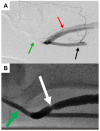Minimally Invasive Limited Ligation Endoluminal-Assisted Revision (MILLER): A Review of the Available Literature and Brief Overview of Alternate Therapies in Dialysis Associated Steal Syndrome
- PMID: 29843483
- PMCID: PMC6025613
- DOI: 10.3390/jcm7060128
Minimally Invasive Limited Ligation Endoluminal-Assisted Revision (MILLER): A Review of the Available Literature and Brief Overview of Alternate Therapies in Dialysis Associated Steal Syndrome
Abstract
Dialysis associated steal syndrome (DASS) is a relatively rare but debilitating complication of arteriovenous fistulas. While mild symptoms can be observed, if severe symptoms are left untreated, DASS can result in ulcerations and limb threatening ischemia. High-flow with resultant heart failure is another documented complication following dialysis access procedures. Historically, open surgical procedures have been the mainstay of therapy for both DASS as well as high-flow. These procedures included ligation, open surgical banding, distal revascularization-interval ligation, revascularization using distal inflow, and proximal invasion of arterial inflow. While effective, open surgical procedures and general anesthesia are preferably avoided in this high-risk population. Minimally invasive limited ligation endoluminal-assisted revision (MILLER) offers both a precise as well as a minimally invasive approach to treating both dialysis associated steal syndrome as well as high-flow with resultant heart failure. MILLER is not ideal for all DASS patients, particularly those with low-flow fistulas. We aim to briefly describe the open surgical therapies as well as review both the technical aspects of the MILLER procedure and the available literature.
Keywords: MILLER; arteriovenous fistula; arteriovenous fistula banding; dialysis associated steal syndrome; high flow.
Conflict of interest statement
The authors declare no conflict of interest.
Figures






References
-
- Saran R., Robinson B., Abbott K.C., Agodoa L.Y., Albertus P., Ayanian J., Balkrishnan R., Bragg-Gresham J., Cao J., Chen J.L., et al. US Renal Data System 2016 Annual Data Report: Epidemiology of Kidney Disease in the United States. Am. J. Kidney Dis. 2017;69:A7–A8. doi: 10.1053/j.ajkd.2016.12.004. - DOI - PMC - PubMed
-
- Malik J., Tuka V., Kasalova Z., Chytilova E., Slavikova M., Clagett P., Davidson I., Dolmatch B., Nichols D., Gallieni M. Understanding the dialysis access steal syndrome. A review of the etiologies, diagnosis, prevention and treatment strategies. J. Vasc. Access. 2008;9:155–166. doi: 10.1177/112972980800900301. - DOI - PubMed
Publication types
LinkOut - more resources
Full Text Sources
Other Literature Sources

